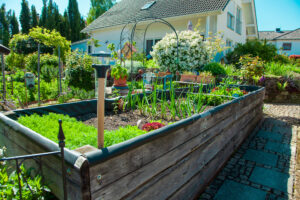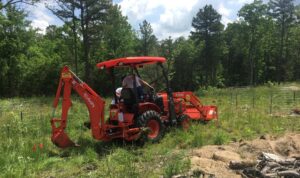Introduction

The purpose of homestead gardens is a bit different from growing a few tomatoes through there is nothing wrong with that. A homestead garden be it in the backyard on on acres of land has a purpose beyond a regular garden. That purpose is more than to produce vegetables. A homestead garden is meant to grow self-sufficiency and decrease your dependency on increasingly broken food system to whatever degree you feel able or led. You might be pleasantly surprised at just how much of your own food you can grown even in a small yard with the right knowledge.
How Much Food Can You Grow in a Homestead Garden?
On a small lot of just 1/10 an acre if you put all you land into food production you have 4356 square feet. Assuming an average 1800 square foot home and another 200 square foot for driveways and out buildings, you still have 2356 square foot worth of growing area.
According to the calculator I found on morningchores.com to grow Basil, Snap Beans (pole), Beets, Broccoli, Cabbage, Carrots, Celery, Corn, Cucumbers, Eggplant, Garlic, Lettuce, Melons, Onions, Parsley, Peas, Peppers, Potatoes, Spinach, Summer Squash, Winter Squash, Strawberry, Sweet Potatoes, Tomatoes, Cherry Tomatoes, and Watermelons for a family of 4, you need 931 square feet of garden.
Of course, this is only approximate as much depends on soil fertility, growing season, and how much your family eats. Still it gives you at least an idea of what is possible even in a very small space. This would leave you room to account for pathways and still have space for a few chickens and perhaps berry patches and beaked hazel nut trees along the edges increasing your food independence even more. Why waste all that space on large expanses of resource consuming lawn when you could convert it to resource producing food plots.
Make a Site Plan
To get your garden up and running you need a plan. The first step is to determine how much sunlight you have and where. Vegetables require about 6 hours of sunlight to produce well. Spend some time observing how the sun moves across your property.
Next decide what you want to grow and write down or make a spread sheet regarding when to plant and when to expect a harvest. Some vegetables can be planted early and produce a harvest early. Radishes for instance prefer cool weather and are ready to harvest in a month. Succession plant every two weeks in April and May, then skip July and plant again in August and September using the same succession planting schedule. Also plan on how you will preserve your harvest. Radishes are good pickled and can be fermented as well.

Take Care of Your Soil
Plants take up nutrient from the soil every year. This need to be replaced in the form of compost. To read more about how to compost check out my article here. The beauty of a homestead garden it you try to waste nothing. The bedding from you rabbits or chickens if you have them, gets added to the compost as does you food scraps and gives you free compost in return. The compost allows your soil to remain fertile
In the fall before you plan to plant in spring, dress you fields or raised beds with several inches of compost and mix into the beds. When you plant in the spiring give another side dressing of compost and use a balanced fertilizer.
If you decide to use raised beds which is my preference, you can use the what is sometimes called the lasagna method right over your existing soil. To do this lay a six sheet layer of newspaper. This breaks down fast but works wonderfully to smother anything growing in the area. followed by cardboards with the tape removed. Don’t use shiny carboard, only the brown kind. I always have lots from Amazon!
I like to follow this with a layer of straw, then compost, then garden soil. I also add in bloodmeal and bonemeal in the straw layer. This will develop into a rich soil that is aided along by the worms that seem to love cardboard that will be ready to plant in the spring. In the winter season when you are not growing plants or if you have a bed lying fallow for a season plant a cover crop like clover. Just be sure to cut it back before it goes to seed.
Another part of taking care you your soil is being aware of what type of soil what your growing needs. Mediterranean herbs such as rosemary, oregano, sage, thyme and lavender for instance prefer sandy soil and dry conditions. They need good drainage and aeration and very little if any soil amendments. To much nitrogen will make these plants leggy and less flavorful. A good soil for these is 70/30 peat free compost and agricultural sand.
Other herbs like basil and cilantro prefer well draining but rich soil such as multipurpose compost. You’d want to avoid soil amended with sand or grit or with high levels of nitrogen.
Irrigation of the Garden
Irrigation systems are a vital component of successful gardening and there are several options available for gardeners. Drip irrigation is the most efficient system as it delivers a steady flow of water directly to plant roots, reducing water waste and promoting healthier plants. It waste less water and delivers it to the roots. This type of irrigation system is ideal for larger gardens with many plants. For smaller gardens or container plants, hand watering or a simple sprinkler system may be enough. Either of these systems can work well with water catchment systems such as gutters hooked up to rain barrels you can hook one rain barrel to another and increase your water holding capacity. Regardless of the type of irrigation used, always water in the morning to allow the foliage time to dry before nightfall. For more information on rainwater harvesting check out my article here.
An option I used, because I have a bit more room and I am still working am not able to get to my property but once a month, Was a system of on contour swales which I planted fruit trees down hill from. I had someone come out and dig these for me after trying the first one by hand! Well worth the money! The purpose of these if to catch runoff and allow it to seep slowly into the ground. When it is very dry, my area is small enough I just fill them with water and let the water percolate into the ground to hold my fruit trees until I can visit again. To learn how to find your contour lines for swale development see this video here.

Finally , it’s important to check your irrigation system regularly for any signs of damage and make sure it is functioning correctly. Additionally, adjust the watering schedule based on the needs of your plants; what works for one plant may not work for another. With a little research and proper maintenance, you can ensure that your garden is healthy and thriving.
Optimizing Growth Potential
So much depends on what plant you are growing. Different plants will have different planting time and different soil and amendment needs. However, I know of no vegetable garden that thrives on total neglect. I wish I did! You can come close with some established perennials and that’s definitely a part of my overall plan but most the vegetable we are talking about here are annuals you will be planting every year. You will need to make a plan based on the plants needs for fertilizing.
When to Fertilize
- Before planting use a granular fertilizer appropriate for the plant you are fertilizing
- Seedlings you are starting inside can be given liquid fertilizer 2-3 times a week as soon as they have emerged.
- When transplanting use a high phosphorous fertilizer to encourage root growth
- After planting side-dress your plants with compost or a granular balanced fertilizer 2-3 times during the growth period.
- Leafy and brassica crops benefit from a high nitrogen fertilizer
- On onions, garlic, lettuce and brassicas you can use blood meal for a side dressing
- At the end of the season put compost on your beds
- Consider growing a cover crop such a clover
Pruning your Plants
Pruning your plants can help with air circulation and fruit production and so much more.
For example pruning tomato plants of new growth from the leaf axes will help concentrate the plants energy on fruit production and open up air circulation. Removing lower dying leaves on your plants can also open up air circulation.
You should also pinch off any early blooms that occur before your plants root system has developed. This will result in a better long-term harvest. Also, several weeks before the first frost date pruning new blossoms will concentrate the plants energy on ripening the fruit already present. root pruning is another method that can speed up ripening of your harvest. Cutting the roots shocks the plant into ripening its fruit. I admit I was a bit horrified the first time I pruned my plants as it seemed counter-intuitive that doing so would be helpful.
Seed Saving
As you harvest your bounty keep an eye on next years garden. Use only none-GMO varieties so you can save seeds for next year By saving seeds, you can cultivate varieties that are particularly well-suited for your climate or soil type, as well as ensure a good harvest the following year. To save seeds, allow fruits and vegetables to ripen fully on the plant before harvesting them. With root vegetables like potatoes store in damp sand in a cool dark place. Once you seeds are collected prepare them for storage by drying, cleaning, and labeling each variety. Finally store your seed in a cool dry place until they’re ready to be planted again.
Harvesting Your Garden
When it comes time to harvest your garden there are a few things to keep in mind. First, be sure to harvest your plants at the right time for optimal ripeness and flavor. This is especially important with vegetables like tomatoes; pick them when they are fully ripe and store them away from direct sunlight.
Second, try not to over-water or over-fertilize your plants as too much of either can cause the fruit to split and rot. Lastly, be sure to inspect your plants for signs of pest damage or disease before harvesting them; if you see any evidence of pests or disease discard the affected parts so they don’t spread to other plants. Don’t compost infected plant material. Burn it instead.
Preserving Your Harvest
Some plants are over achievers! Summer squash comes to mind. So what can you do with your abundance? You can share of course with neighbors and the local food bank perhaps. Freezing is an option for many vegetable. Dehydrating works well for herbs. Canning is a great way to have food you know was pesticide free through the winter. Finally, my favorite is fermenting! Consider making a batch of sauerkraut, kimchi, or pickles to enjoy all winter long.
No matter what you decide to do with your garden bounty, be sure to have fun! Enjoy the fruits of your labor and reap the rewards for months to come. Happy Harvesting!
